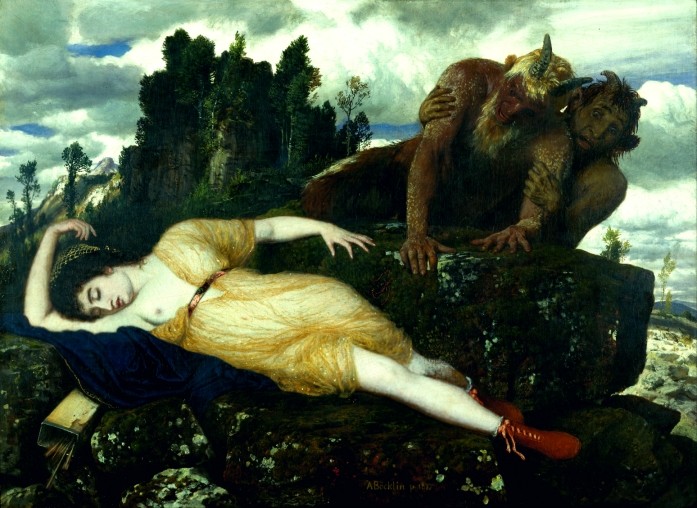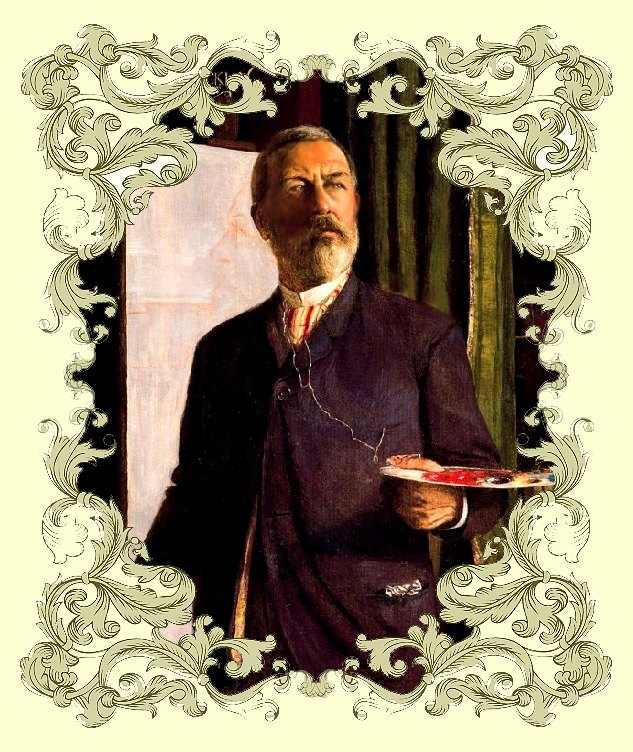ARNOLD BOCKLIN
The Deposition
ARNOLD BOCKLIN
Spiel der Wellen 1883
ARNOLD BOCKLIN
Die Klage des Hirten 1866
ARNOLD BOCKLIN
Island of the Dead, Third Version
ARNOLD BOCKLIN
Mädchen und Jüngling beim Blumenpflücken
1866
ARNOLD BOCKLIN
Sleeping Diana Watched by Two Fauns

ARNOLD BOCKLIN
Oct. 16, 1827 - Jan. 16, 1901
Sel-Portrait
BIOGRAPHY
Arnold Böcklin was born on Oct. 16, 1827,
in Basel. He attended the Dusseldorf Academy
(1845-1847). At this time he painted scenes
of the Swiss Alps, using light effects and
dramatic views subjectively to project emotional
moods into the landscape. In 1848 this romantic
introspection gave way to plein air (open-air)
objectivity after he was influenced by Camille
Corot, Eugene Delacroix, and the painters
of the Barbizon school while on a trip to
Paris. But after the February and June revolutions
Böcklin returned to Basel with a lasting
hatred and disgust for contemporary France,
and he resumed painting gloomy mountain scenes.
In 1850 Böcklin found his mecca in Rome,
and immediately his paintings were flooded
by the warm Italian sunlight. He populated
the lush southern vegetation, the bright
light of the Roman Campagna, and the ancient
ruins with lonely shepherds, cavorting nymphs,
and lusty centaurs. These mythological figures
rather than the landscapes became Böcklin's
primary concern, and he used such themes
as Pan Pursuing Syrinx (1857) to express
the polarities of life: warm sunshine contrasts
with cool, moist shade, and the brightness
of woman's spirituality contrasts with man's
dark sensuality.
When Böcklin returned to Basel with his Italian
wife, he completed the painting which brought
him fame when the king of Bavaria purchased
it in 1858: Pan among the Reeds, a depiction
of the Greek phallic god with whom the artist
identified. He taught at the Academy of Art
in Weimar from 1860 to 1862, when he returned
to Rome. Called to Basel in 1866, he painted
the frescoes and modeled the grotesque masks
for the facade of the Basel Museum.
Böcklin resided in Florence from 1874 until
1885, and this was his most active period.
He continued to explore the male-female antithesis
and painted religious scenes, allegories
of Nature's powers, and moody studies of
man's fate. He ceased working with oils and
began experimenting with tempera and other
media to obtain a pictorial surface free
of brushstrokes.
Böcklin spent the next 7 years mostly in
Switzerland, with occasional trips to Italy;
he devoted much of his energy to designing
an airplane. Following a stroke in 1892,
he returned to Italy, bought a villa in Fiesole,
and died there on Jan. 16, 1901. Many of
his late works depict nightmares of war,
plague, and death.
Böcklin exercised an influence on Surrealist
painters like Max Ernst and Salvador Dalí,
and on Giorgio de Chirico. Otto Weisert designed
an Art Nouveau typeface in 1904 and named
it "Arnold Böcklin" in his honor.
Böcklin's paintings, especially The Isle
of the Dead, inspired several late-Romantic
composers. Sergei Rachmaninoff and Heinrich
Schülz-Beuthen both composed symphonic poems
after it, and in 1913 Max Reger composed
a set of Four Tone Poems after Böcklin of
which the third movement is The Isle of the
Dead (The others are The Hermit playing the
Violin, At play in the waves and Bacchanal).
Hans Huber's second symphony is entitled
"Böcklin-Sinfonie", after the artist
and his paintings. Rachmaninoff was also
inspired by Böcklin's painting The Return
when writing his Prelude in B Minor, Op.
32, No. 10. Adolf Hitler was fond of Böcklin's
work, at one time owning 11 of his paintings.
When asked who was his favorite painter,
Marcel Duchamp controversially named Arnold
Böcklin as having a major influence on his
art. Whether Duchamp was serious in this
assertion is still debated. H. R. Giger has
a picture called "Hommage to Boecklin",
based upon "Isle of the Dead
THE SURREALISM
The Surrealist movement began as a literary
group strongly allied to Dada, emerging in
the wake of the collapse of Dada in Paris,
when André Breton's eagerness to bring purpose
to Dada clashed with Tristan Tzara's anti-authoritarianism.
Breton, who is occasionally described as
the 'Pope' of Surrealism, officially founded
the movement in 1924 when he wrote "The
Surrealist Manifesto." However, the
term "surrealism," was first coined
in 1917 by Guillaume Apollinaire when he
used it in program notes for the ballet Parade,
written by Pablo Picasso, Leonide Massine,
Jean Cocteau, and Erik Satie.
Around the same time that Breton published
his inaugural manifesto, the group began
publishing the journal La Révolution surréaliste,
which was largely focused on writing, but
also included art reproductions by artists
such as de Chirico, Ernst, Arnold Böcklin,
André Masson, and Man Ray. Publication continued
until 1929.
The Bureau for Surrealist Research or Centrale
Surréaliste was also established in Paris
in 1924. This was a loosely affiliated group
of writers and artists who met and conducted
interviews to "gather all the information
possible related to forms that might express
the unconscious activity of the mind."
Headed by Breton, the Bureau created a dual
archive: one that collected dream imagery
and one that collected material related to
social life. At least two people manned the
office each day - one to greet visitors and
the other to write down the observations
and comments of the visitors that then became
part of the archive. In January of 1925,
the Bureau officially published its revolutionary
intent that was signed by 27 people, including
Breton, Ernst, and Masson.
There were two styles or methods that distinguished
Surrealist painting. Artists such as Dalí,
Tanguy, and Magritte painted in a hyper-realistic
style in which objects were depicted in crisp
detail and with the illusion of three-dimensionality,
emphasizing their dream-like quality. The
color in these works was often either saturated
(Dalí) or monochromatic (Tanguy), both choices
conveying a dream state.
Several Surrealists also relied heavily on
automatism or automatic writing as a way
to tap into the unconscious mind. Artists
such as Miró and Ernst used various techniques
to create unlikely and often outlandish imagery
including collage, doodling, frottage, decalcomania,
and grattage. Artists such as Arp also created
collages as stand-alone works.
Hyperrealism and automatism were not mutually
exclusive. Miro, for example, often used
both methods in one work. In either case,
however the subject matter was arrived at
or depicted, it was always bizarre - meant
to disturb and baffle.
THE SURREALISM
IN ARTE EST LIBERTAS
MOVEMENTS-ARTISTS




